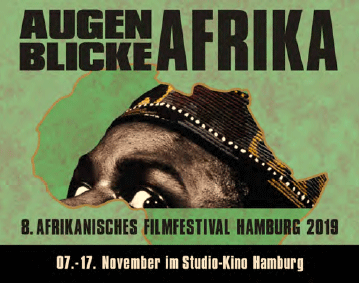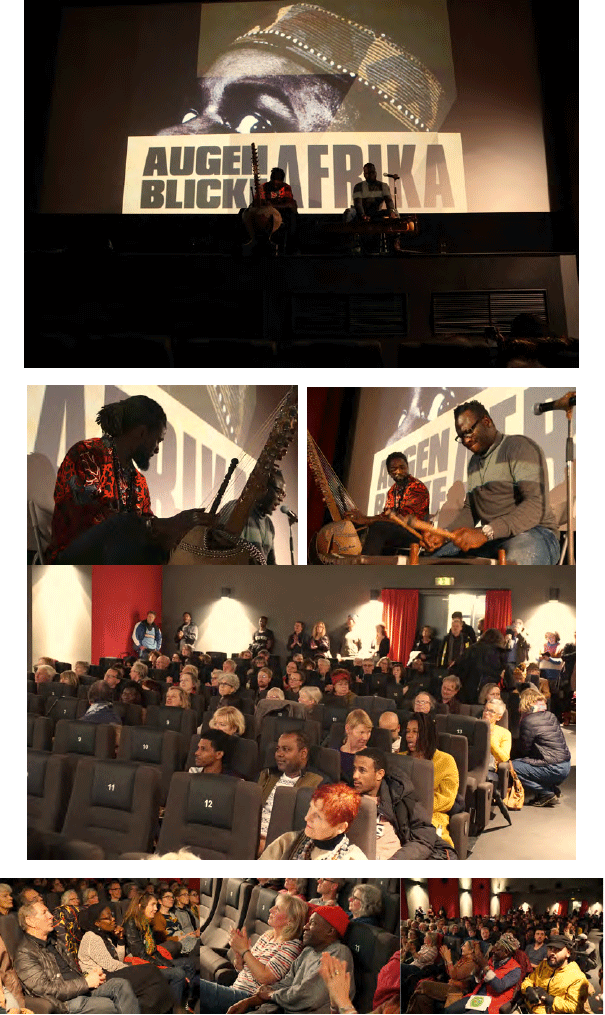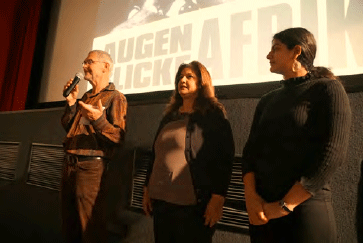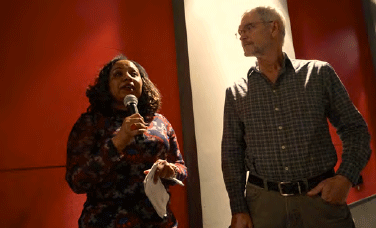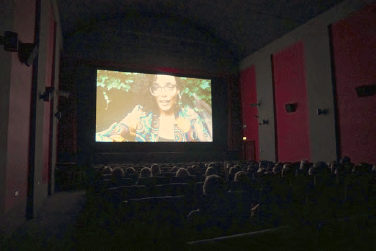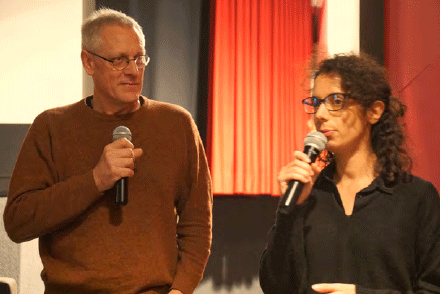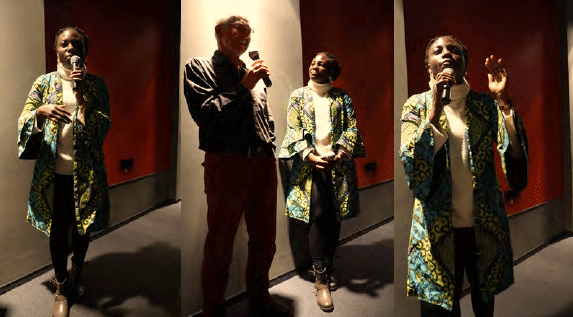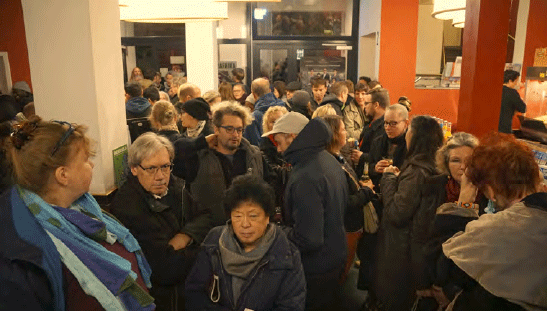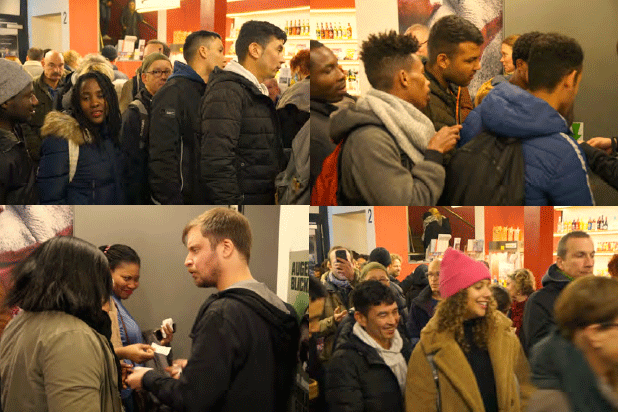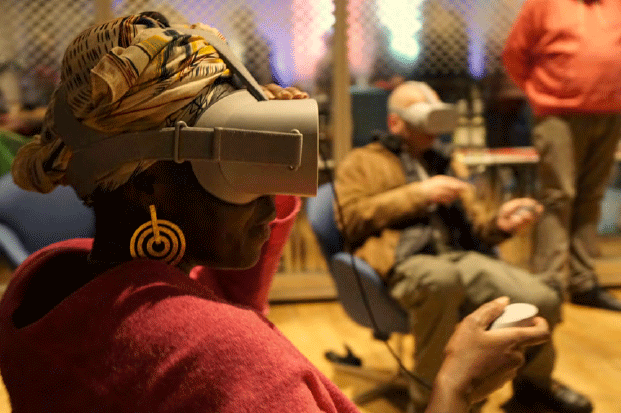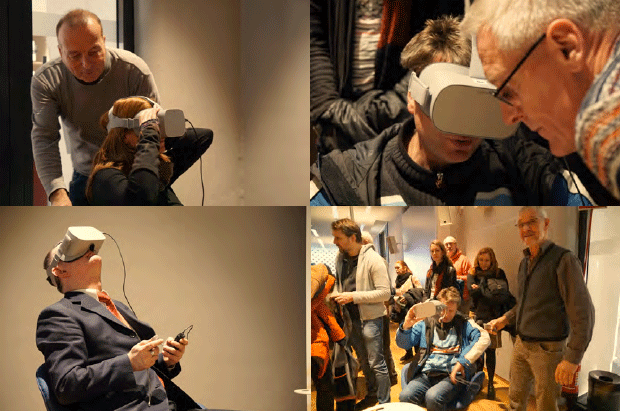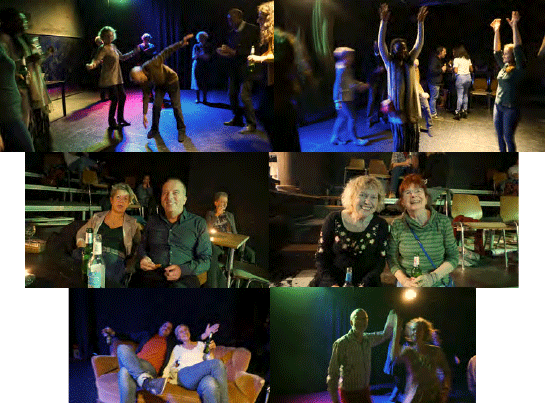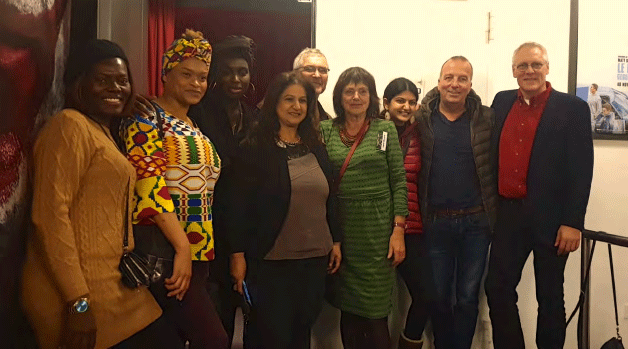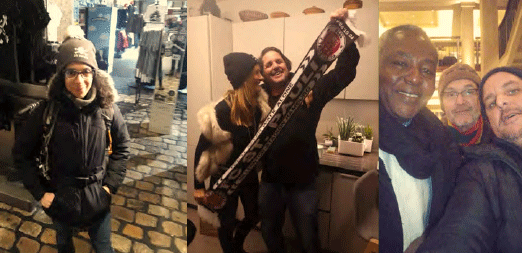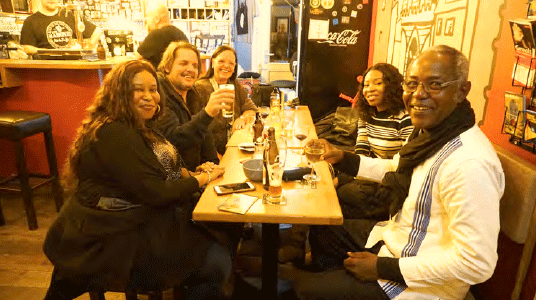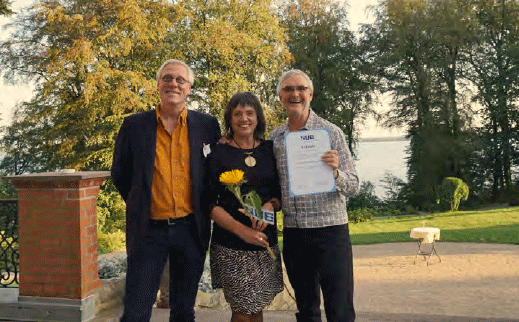Last year we presented 50 films from 20 countries at our 8th African film festival in the Studio cinema on Bernstorffstrasse.
These new productions, often by young African directors, denounce social grievances, show a diverse urban life and often give intimate insights into changing family, social and political structures in African societies. It is striking that the films are not superficially political, but deal with the inner life of their protagonists in a differentiated way. Our program selection appealed to a wide audience more than ever and on several occasions it was regretted that one could not watch all films. The audience was particularly involved in discussions when directors of films were present at the show.
As always there was finger food and drinks being served at the festival opening. This year we invited the Senegalese Kora virtuoso Saliou Cissokho and the Balafon player Mansa Dembele from Burkina Faso for a 40 minute concert in front of the screen of the Studio cinema.
The audience in the sold-out cinema listened intensly to the sounds of this old traditional West African Mandingo music. Without encores, Saliou Cissokho and Mansa Dembele were not allowed to leave the hall. After greeting the guests, the obligatory speech to tune everybody into the mood for the festival and thanks to our sponsors, we showed the opening film SUBIRA.
This year, the focus lay on films that show young, strong women who are no longer satisfied with their traditional roles and who revolt openly against old role models.
The film SUBIRA by Kenyan director Rauneet Sippy Chadha who was present at the opening stands programmatically for this fight. A young woman from Lamu Island is fighting to learn to swim – an outrageous wish in Muslim society.
Hans-Jörg Heinrich, Sippy Chada, Sahiba Chada
In the discussion that followed, it became clear that Chadha, as an African filmmaker, has to take into account the domestic audience in developing the plot and to build on the status of society’s development.
In African countries her film was viewed very differently from Europe. Her film has been awarded numerous prizes so far. The film KHARTOUM OFFSIDE by Marwa Zein from Sudan shows a group of young women who are fighting to be allowed to play football, even though this contradicts the moral standards of their conservative Muslim society and families.
Eiman Seifeldin und Hans-Jörg Heinrich
We invited the Sudanese activist Eiman Seifeldin, who fights human rights violations in Sudan. In moving words, she described the tense political situation in Sudan and the tough struggle of many women for social equality and participation.
In ihrem rasant gedrehten Road-Movie FLATLAND erzählt die südafrikanischen Regisseurin Jenna Bass anhand des Schicksals dreier junger Frauen von weiblicher Selbstbestimmung unter den gesellschaftlichen Machtverhältnissen in Südafrika. Irgendwo zwischen Polizeithriller,
Emanzipationsgeschichte und Gesellschaftsdrama beerdigt sie dabei ein weiteres Mal den Mythos von der südafrikanischen „Rainbow Nation“. Die zu diesem Film eingeladene Hauptdarstellerin Nicole Fortuin hatte leider kein Visum erhalten, konnte aber per Videobotschaft ihre Verbundenheit mit unserem Festival zum Ausdruck bringen.
Nicole Fortuin
With DHALINYARO (JEUNESSE) we showed a film from Djibouti for the first time. Lula Ali Ismail is the first director to ever make a film there.
It tells the story of a close friendship between three self-confident young women who are trying to realise their dreams for the future. The director gave the audience fascinating insights into modern life in this small state in Eastern Africa.
Many African countries are still dominated by fundamentalist struggles. We presented several films about this issue.
In FATWA Tunisian director Mahmoud Ben Mahmoud tells the story of a young man who had joined a radical Islamist group and was killed in a car accident. At first sight seeming to be a criminal case his father by and by finds that there is more behind his death and is increasingly targeted by Islamists.
Against the backdrop of violent demonstrations for an Islamist state the creative and radically staged Moroccan film RAZZIA by Nabil Ayouch portraits five very different people all desperately striving for change, self-determination and freedom.
In the short film BROTHERHOOD, Tunisian director Meryam Joobeur tells of a young IS fighter who returns to his family from Syria.
The film SANKARA N’EST PAS MORT by young director Lucie Viver was a hit with the public. It pays homage to Thomas Sankara, the charismatic and later murdered president of Burkina Faso.
Viver accompanies the young poet Bikontine on a journey through the country in his search for identity and future. There he meets a wide variety of people, gets to know their different living conditions and learns about their dreams and disappointments. The film paints a complex picture of Burkina Faso’s people, whose future is uncertain. In the discussion after the show, Lucie Viver explained how, on several trips, she first traveled the country without a camera, did extensive research and got to know the poet Bikontine, who agreed to act as the protagonist of the film.
Burkhard Leber and Lucie Viver
In the tradition of African storytelling, we showed two different films from Burkina Faso and Nigeria. In their road movie DUGA LES CHAROGNARDS, the directors Abdoulaye Dao and Hervé E. R. Lengani from Burkina Faso deal with the religions present in West Africa. Muslim, Catholic, Protestant, Evangelical and animistic cemetery keepers successively refuse to bury a deceased. The film is peppered with many swipes on traditional and religious leaders, on bureaucracy and corrupt police, selfishness and greed for money. For us Westerners, the satiric tragicomedy gives rather unusual insights into a foreign culture.
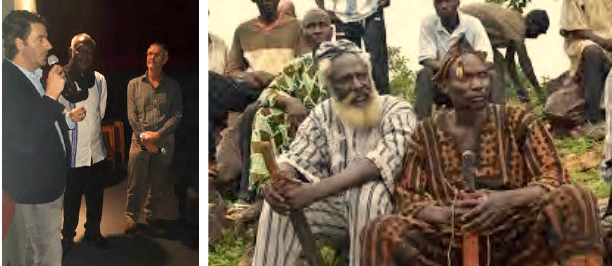
Sébastien Martineau and Abdoulaye Dao | Filmstill
In the subsequent discussion, Abdoulaye Dao, who was present, explained to us that many popular television series in West Africa package their criticism of social, political and religious conflicts in a humorous way in often bizarre stories. The film Duga – the vulture – takes up this popular narrative art.
The first film Kassala by the young Nigerian filmmaker Ema Edosio is completely different. The comedic film takes place in original locations in the slums of Lagos and thus stands out from the usual Nollywood productions.
Edosio tells a tragic story that many young people in today’s Nigeria can identify with, because their reality also seems hopeless.
Ema Edosio and Hans-Jörg Heinrich
In the discussion after the film, Ema Edosio enthusiastically explained her intentions in making the film. She deliberately chose the four loud, rough, often intrusive and silly characters because they reflect the reality of the urban youth. Only the loudest and most brutal prevails. Poverty and lack of money are prevalent, and a little misfortune can cause great personal tragedy. However, everything is played in a comedic manner, because the Nigerian audience expects this. Edosio, however, never leads the action of her protagonists to the absurd, but keeps it close to reality. The Hamburg audience thanked the director for her explaining the cultural background.
An extraordinary film of just another kind is the debut film THE BURIAL OF KOJO by the Ghanaian musician Blitz the Ambassador. In it, cinema viewers are immersed in the magical world of a little girl. In search of her father, images of fantasy and reality mix with worlds that exist between life and death. Many of the symbolic images still have to be decrypted. The film music composed by the musician himself contributed a lot to the often magical mood of the film.
Unfortunately, the director could not be present. He could have helped in the interpretation. So the audience left the film thoughtful.
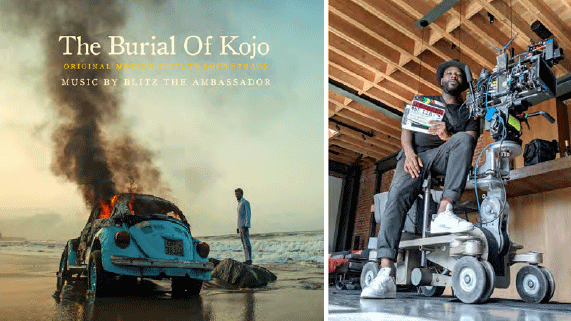
As every year, we showed a film in collaboration with Amnesty International. This time we presented the Sudanese film TALKING ABOUT TREES. Four old veterans of Sudanese filmmaking indulge in memories of their “Sudanese Film Club”. In the totalitarian Islamic country of the 90s however, it was considered dangerous to show films and cinemas were closed.
Now we are learn from the media that the first outdoor film screenings have recently taken place in Khartoum.
Committed and knowledgeable, Thomas Grand, the director of the film Poisson d’or, poisson Africain – Golden Fish, African Fish, responded to questions from the audience. With beautiful pictures he and co-director Moussa Diop showed in their impressive documentary film an ecological and economic drama in the small port town of Kafountine on the Atlantic coast of Casamance / South Senegal. Fishing and the manufacturing industry are threatened by overfishing by large trawlers off the coast, by increasingly scarce firewood and a newly built Chinese fish meal factory.
Dörte Staehler and Thomas Grand
The Nest Collective from Nairobi presented a series of eight short films under the ironic title We Need Prayers. They tell everyday stories that every Kenyan is only too familiar with, wonderfully observed and staged.
The term Afrofuturism appears again and again in the African art scene. Many artists in Africa and in the diaspora deal with science fiction films and virtual realities on topics of the future, of visions and utopias. With the help of a series of short film and the enormous Black Panther by Ryan Coogler, we wanted to investigate into this term in a discussion with experts after the film.
For this, the audience poured into the hall.
We could win producer and director Jean-Alexander Ntivyihabwa, who lives in Hamburg, for a follow-up discussion. In summer he co-directed the film “Africa Rising” for Arte, which started with an appreciation of the film Black Panther. Ntivyihabwa pointed out that in Black Panther African traditions and mythologies are combined with the most modern technological elements in order to create postcolonial identity which is detached from the West and is located in an Afrocentric future. In contrast to previous science fiction films, all the heroes of the film and the director are of African origin. This was celebrated in African communities worldwide. The audience thanked Mr. Ntivyihabwa for the insightful classification with great applause. The mostly young viewers were equally fascinated by the short films shown the day before produced by young mostly Kenyan directors on the subject of Afro-Futurism.
This year the music films came from Cuba (BAKOSÓ) and from Berlin (AFRO X BEATS X BERLIN). Afrobeat takes center stage in both productions. The predominantly young audience was enthusiastic about the fresh music. In the Cuban film, young DJ Jigüe travels 900 km from Havana to Santiago, where he encounters an even greater awareness of the African musical heritage of the Cubans. The director of the other film, David Yaw Debrah from Berlin, had come to join the festival and led an intensive conversation about the developing

Filmstill Bakosó | David Yaw Debrah
A special event this year was the screening of virtual reality (VR) films from Kenya, Senegal and Ghana in the public library near Hamburg’s central station. The films presented the diverse and constantly changing cultural landscape of today’s Africa.
A crowd of visitors filled the libary’s event hall for the official opening. Kora player Samba N’Diaye from Senegal enchanted the public with his music. Since our invited African guests had to unfortunately cancel at short notice, Hans-Jörg Heinrich from AUGEN BLICKE AFRIKA e.V. gave a small introduction to the intent and topic of the films “African Futures”.
There were six VR headsets provided for the guests to watch the films with lengths of about seven to ten minutes. Curiosity followed by fascination and enthusiasm were the most imminent reactions to the new viewing experience.
By way of the interest in modern technology interest in Africa was created and vice versa. The interest in African films introduced viewers to the VR technology. Thus a two way effect was created. For the next two days, headsets were in use all the time. A great success for us and a great experience for the audience.
Samba N’Diaye
At 10 p.m. on the last Saturday of the festival, our closing party in the MUT theater started with African dance music from classics to Afrobeat.
The presence of the African directors gave the opportunity of personal encounters, intensive exchange and city tours with our guests. This resulted in counter-invitations and the assertion of further good cooperation. Even two new fans of Sankt Pauli’s football club were born.
AUGEN BLICKE AFRIKA nach der Eröffnung
Lucie Viver | Thomas Grand Abdou | Hans, Thomas
an den Landungsbrücken: Ema, Hans-Jörg, Thomas, Rolf
Sippy Chada in Övelgönne | Thomas, Abdou, Hans, Rolf
Nachbesprechung in der Kneipe
In September we very happily received an award for outstanding projects of non-profit organizations from the North German Foundation for Environment and Development (NUE). We are very happy about this recognition of more than eight years of voluntary work for the festival.
Für den Verein die Gründungsmitglieder Burkhard Leber, Ingrid Wernich
und Hans-Jörg Heinrich
We would like to end this review with a thank you letter by Ilsemargret Luttemann, a lecturer at the University of Lüneburg, who visits our film festival every year with a class of students.
The wonderful filmfestival AugenBlicke in Hamburg (the 8th edition!!!) has
closed its curtains yesterday evening and I got so sad but I have to admit that
I need now some time to step back and think about all the wonderful films that
I have seen. What a diversity in styles and genres, we met quite a number of
different film directors and other people who commented on the films or the
political situation of the country from which the films originated. I want to
express my deepest gratitude and admiration for the professional work that
the team of organizers has invested to make the festival such a success and
point of attraction. It gets more and more visitors each year because the
quality of the films and the presentation, the warm welcome to the spectators
transform it into a reliable and good product. It gives us informations on Africa
or certain topis, it provides us with new insights. Thank you so much to Indrid
Wernich, Hans-Jörg Heinrich, Burkhard Leber, Rolf Denkewitz und Astrid
Kühl. We are waiting impatiently for the next festival to come!!!
I give a price to my favourite doumentary “Sankara n’est pas mort” (Sankara
is not dead) from Lucie Viver, another price goes to “The burial of Kodjo” from
Blitz Bazawule together with “La miséricorde du jungle” (The mercy of the
jungle) by Joel Karekezy. Hopefully they all make it to the movies!
Ilsemargret Luttemann
